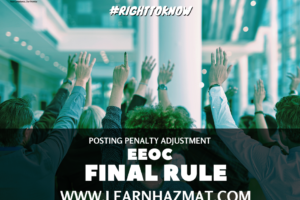How To Fall Out Of Hazmat Compliance
Regulatory differences between various modes of transport can be challenging for and misunderstood by organizations. Therefore, they end up making mistakes when preparing their dangerous goods for transportation. A major cause to this issue is untrained and non-compliant employees who unknowingly commit regulatory violations when packaging and preparing transport documents for transporting dangerous goods. This article discusses some of the common mistakes that employees and businesses make when preparing hazardous materials, as well as the rules to follow in order to remain compliant.
Compliance Rules For Transporting Dangerous Materials
The Principle Of Distinction
Both transport and warehouse management, as well as employers, must ensure that they hire employees who are able to distinguish the materials that they handle, make sure they are familiar with the materials that are often misjudged to be non-hazardous, and always clearly label the packages. Employees should be familiar with the domestic and international regulatory requirements that govern the transportation of the materials they handle.
Trained Personnel
To avoid safety issues and problems with the regulatory authorities, employers must train employees on the correct procedures for handling dangerous goods. Training should range from recognizing the hazardous characteristics of the goods to preparing the goods for the appropriate mode of transport. Failure to do so will result in an unsafe workplace and put the public at risk when these goods are in transportation.
Comply With Hazardous Material & Dangerous Goods Transportation Regulations (HMTA of 1975)
The domestic hazardous material transportation regulations and the various international dangerous goods transportation regulations outline the most vital procedures and packaging requirements for these hazardous goods. Therefore, employees should familiarize themselves with these operational rules in order to avoid serious consequences of unsuitable shipping. These regulations are imperative in protecting the public from any form of exposure to hazardous materials.
Common Mistakes Made When Transporting Dangerous Goods.
Failure To Understand The Regulatory Difference Between Modes Of Transportation
Although there is harmonization between the regulations for the different modes of transportation, there are also differences due to the unique risks associated with the transport mode. Items permitted for transport by ground are sometimes not allowed to be transported by aircraft or vessel in the same quantities or packaging. Stowage and segregation may be more of a concern when preparing certain dangerous goods for transport under the deck of a ship. Therefore, it becomes extremely dangerous when the concerned entities fail to make this distinction.
Assuming That Common Substances Are Non-Hazardous
This situation is one in which hazardous material are handled by employees who are not properly trained or do not clearly understand the risks associated with the materials they handle. They make assumptions that certain goods, such as lithium batteries, are not hazardous and inadvertently violate the hazardous materials and dangerous goods regulations which put themselves and others at risk.
Certification of Hazmat employees
Certifying employees who have responsibilities for preparing hazardous materials for transportation is the responsibility of each hazmat employer. The first step for all hazmat employees is thorough training so that they are qualified and competent in their hazardous goods duties. It is therefore, up to the employer to determine the level of competency of their employees before they are permitted to perform hazardous goods functions. Failure to do this can be a recipe for future safety and transportation violations.
Returns and Self-Transportation Issues
Warehouse receiving personnel may be unaware that they are handling regulated materials. The warehouse receiving manager or employee may receive an item that was not ordered and, therefore, needs to be returned to the supplier. When not aware that it is a hazardous material shipment, transportation regulations are not followed, thereby creating an unsafe condition, as well as a violation of the regulations.
To conclude, organizations should avoid mistakes that can lead to safety issues and legal consequences by putting their employees through all hazmat training. Through training, employees will demonstrate their knowledge and understanding of the risks associated with handling hazardous materials and the regulations that govern their safe transport, both within the country and across the continents. It is imperative that these regulations are well understood.
If your business handles or prepares hazardous materials for transport, it is of utmost importance that you remain compliant with current safety procedures and regulations. Transportation Compliance Associates makes staying current and compliant easy. Call 412-249-1111 to talk with our experts today!
Tag:Hazmat training, safety





